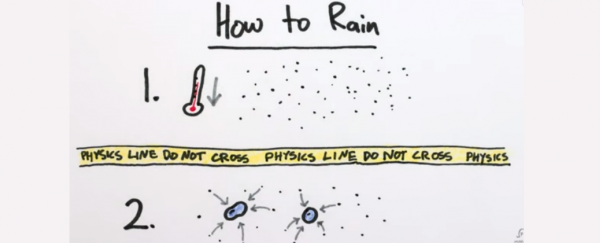"There's a lot of physics going on in raindrops, says Henry Reich in the latest episode of MinutePhysics. "Cohesion, adhesion, air resistance - falling raindrops often look more like jellyfish than teardrops. But perhaps the most fascinating is the physics that makes raindrops impossible."
What does that even mean? Well, when you think about how raindrops form, it seems pretty simple - cool the water vapour held in the atmosphere past its condensation point, and you now have a healthy supply of liquid droplets, right? Not so fast, says Henry, because we need to consider the surface of the liquid droplets, which need to follow a whole other set of physical laws.
Liquids are slaves to the laws of intermolecular attraction, which means all the molecules in a drop of liquid will pull together to try and minimise the outer surface area. This is because volumes cost less 'free energy' than surfaces. So when we're condensing water vapour into a liquid to make raindrops, every cubic centimetre volume of water that's converted releases energy, but then to make each square centimetre of the surface, you're gonna need an input of energy.
It doesn't need much, but it's more than enough to make up the energy cost due to the surface area, says the episode of MinutePhysics above. Where things get complicated is when the surface area grows, which requires more energy than is released from the volume energy. This means raindrops don't grow, they shrink.
This is much more effectively explained through mathematics, so watch the video above to see how it's done, and have everything it didn't occur to you to consider about raindrops till two minutes ago blown away by the laws of physics.
